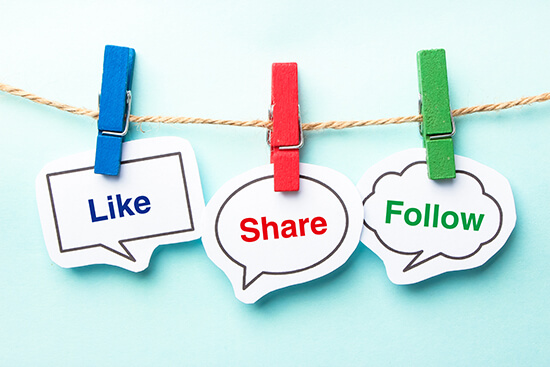
Earlier this year, Fractl partnered with BuzzSumo to look at one million of the most shared articles between December 2015 and May 2016.
Research revealed that Facebook is capturing more than 90 percent of all social shares, up from 82 percent in 2014.
While Facebook has been monopolizing social engagement, we’ve seen a parallel increase in the number of websites with content that’s receiving a high level of social engagement.
As Facebook continues to alter its News Feed algorithm to discourage clickbait and encourage greater publisher diversity, we are likely to see fewer social media juggernauts and a wider pool of sites that are getting thousands of content-based interactions.
Now is as good a time as any to dust off your social media strategy and see if you can increase social engagement on Facebook.
To help you do so, we looked at how Upworthy and National Geographic consistently create shareworthy content.
We also took a look at NowThis, which doesn’t appear on our list of top sites, but has been racking up Facebook engagement through a different method.
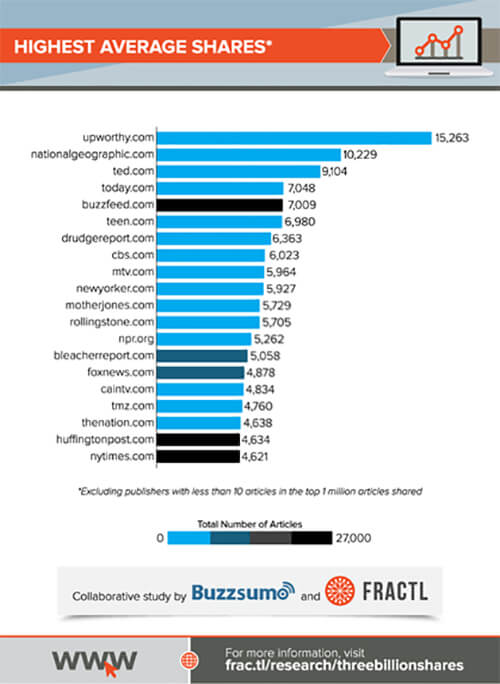
Upworthy
Across 1,085 articles, the average share count was 15,263.
In 2014, Upworthy was the number seven site for the total number of shares.
In 2016, however, Upworthy did not even crack the top 20.
Although its total shares have dropped since 2014, Upworthy still has the highest average share count across all of the analyzed articles.
What accounts for their success to this point, then, and what lessons can we learn from its decline?
Focus On Positive Emotions
Upworthy is extremely effective at creating emotional content.
For instance, their most-shared article of the past six months was “Dad and Daughter Relationships As Explained by Ten Paintings.”
The article features the heartwarming artwork of Ukrainian painter, Soosh.
Upworthy doesn’t shy away from covering difficult topics, either, but always focuses on the hopeful aspects of each story.
This article, “102 Days After His Wife’s Death, Patton Oswalt Describes Grief As Only He Can” addresses the loss of a loved one, but is included in a section titled “Inspiration” (which is consistent with the article’s tone).
Of their top 100 articles between December 2015 and May 2016, every single article had a positive sentiment.
Positive emotions are prime content for virality.
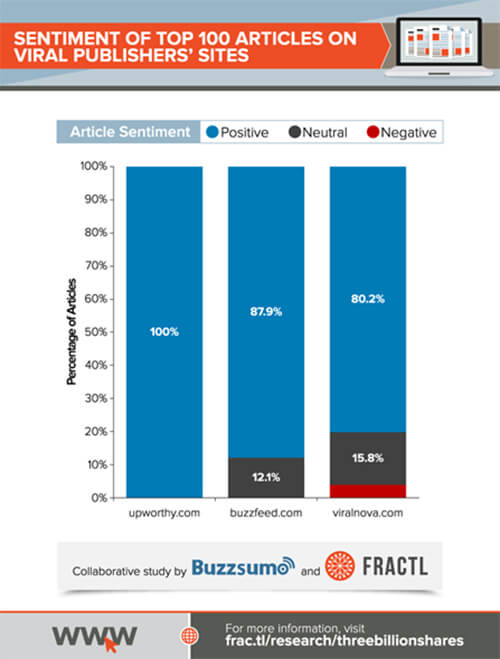
Although their model of curating emotionally powerful content coupled with curiosity-gap headlines worked in 2014, it isn’t a lasting model.
Between the Facebook algorithm changes and the internet’s clickbait fatigue, Upworthy experienced a sharp drop in organic traffic last year.
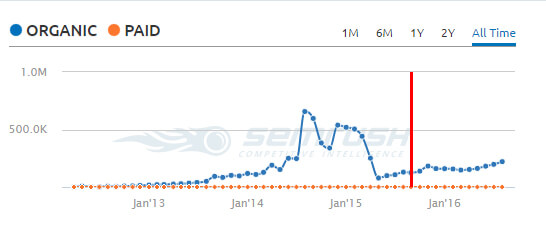 Earlier this year, Upworthy reorganized to focus more of the company’s energy on original video content.
Earlier this year, Upworthy reorganized to focus more of the company’s energy on original video content.
Although its traffic has been increasing since January, the jury is out on whether or not the new strategy will be effective.
Be Careful of Data Dependency
This second point might not be a popular one, but one of the main lessons we can learn from the difficulties Upworthy had in the past year is to not rely too heavily on data.
The site’s signature headlines were the result of extensive testing.
Even though Upworthy has purportedly moved away from clickbait headlines, the company will have a hard time disassociating itself from content that over-promises, but under-delivers.
Headline testing proved that curiosity gap–style headlines were effective at attracting readers.
However, data didn’t predict that these types of headlines would become widely viewed as “insufferable” and “manipulative.”
Data only shows us what we decide to test.
Additionally, human intuition can be better at spotting the difference between an effective tactic and a gimmick, rather than an algorithm.
Although Upworthy may be able to regain the internet’s trust, it will be an uphill battle.
National Geographic
Across 2,884 articles, the average share count was 10,229.
National Geographic was popular before the internet, and although its initial progress may have been slow and its business model is still adapting, the organization has been highly effective at gaining social traction with its content.
The publication has the second-highest average share count of our sample—our analysis looked at social engagement across Facebook, Twitter, LinkedIn, Pinterest, and Google+.
A study by Shareablee—which looks at social engagement across Facebook, Twitter, Instagram, and YouTube—ranked National Geographic as the top social brand in the United States.
The company is popular on Snapchat as well, and its overall organic traffic has been steadily increasing since 2010.
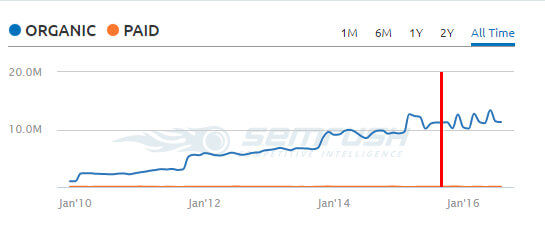
Create High-Quality Content and Adapt to New Platforms
National Geographic has been doing so well because it creates great content—and has always created great content.
Its success throughout the years is a reminder of the durability of quality.
In particular, the publication is known for its photographs, which spread easily across different social platforms.
However, great content goes nowhere without effective promotions, and National Geographic has been careful to adapt to changing technologies and audience expectations.
For instance, it curates platform-specific experiences for its followers, and the brand is not afraid to gamble on new technologies.
Feed Your Audience’s Curiosity
National Geographic and Upworthy both know the power of audience curiosity (although, admittedly, they harness it in different ways).
Although some of its most shared pieces of content are photographs, this informational page about pufferfish has been shared more than 155,000 times.
Another top National Geographic post (with more than 90,400 shares) lets readers scroll through data about different types of sharks.
Part of their brand is that it develops trustworthy, scientific content that’s also accessible to the average person.
The publication’s headlines, therefore, promise an exploration of a certain topic (e.g., sharks) in a way anyone can understand.
NowThis
NowThis doesn’t appear on our list as a top shared site because it distributes 100 percent of its content across social media and publishing platforms, but it has been making waves.
In fact, it was the most watched news publisher on Facebook from June 2015 to June 2016.
In July 2016 alone, the publishers’ content generated more than one billion views on Facebook.
Although their 100 percent distributed content model is not for every publisher or every brand (in fact, monetization has been difficult for the network), we can still learn from the company’s social engagement strategies.
Develop a Robust Distribution Network and Tailor Your Content to Each Channel
Athan Stephanopoulos, the SVP of strategy and partnerships for NowThis, said:
We don’t create one video and then cut that video down to 15 seconds so that it can run on Instagram, and cut it down to six seconds so it can run on Vine. We will actually tell the story in a different way that is visually conducive to the platform.
NowThis, like any publisher that is effective on social media, doesn’t just cross-post its Instagram videos onto Facebook.
The company would rather tell the same story in completely different ways for each network.
Like BuzzFeed, the NowThis distribution network is not limited to social platforms.
In fact, NowThis publishes its content on BuzzFeed, AOL, Yahoo, and MSN.
It’s not enough to create a robust distribution network for your content, it’s also important to optimize for every social platform and distribution partner.
Reduce Friction
After NowThis had stopped publishing content on its homepage in February 2015, the audience grew 1,500 percent!
Rather than using social media to drive users to content, NowThis makes social media the final destination.
Although traditional brands and publishers do want users to ultimately visit their site, it is important to post both social media content that directs users to your website, as well as, content that a user can consume directly on the platform.
NowThis is the king in frictionless content consumption, and we can learn from its example.
Learn Social Engagement From Others and Listen to Your Audience
Every publication has a unique social media footprint, and the tactics that work for one audience may fall flat with another.
While it is important to pick up tricks from socially successful content creators, the key is to listen to your audience’s interests and preferences.
image credit: shutterstock. graph credits: Lillian Podlog and Fractl